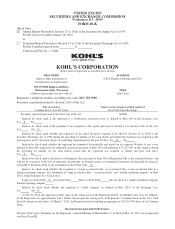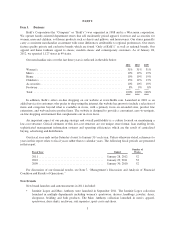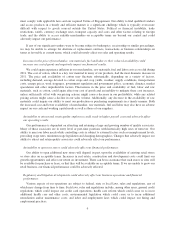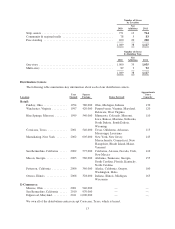Kohl's 2011 Annual Report Download - page 8
Download and view the complete annual report
Please find page 8 of the 2011 Kohl's annual report below. You can navigate through the pages in the report by either clicking on the pages listed below, or by using the keyword search tool below to find specific information within the annual report.Inefficient or ineffective allocation of capital could adversely affect our operating results and/or shareholder
value.
Our goal is to invest capital to maximize our overall long-term returns. This includes spending on inventory,
capital projects and expenses, managing debt levels, and periodically returning value to our shareholders through
share repurchases and dividends. To a large degree, capital efficiency reflects how well we manage our other key
risks. The actions taken to address other specific risks may affect how well we manage the more general risk of
capital efficiency. If we do not properly allocate our capital to maximize returns, we may fail to produce optimal
financial results and we may experience a reduction in shareholder value.
Changes in our credit card operations could adversely affect our sales and/or profitability.
Our credit card operations facilitate sales in our stores and generate additional revenue from fees related to
extending credit. The proprietary Kohl’s credit card accounts have been sold to an unrelated third-party, but we
share in the net risk-adjusted revenue of the portfolio, which is defined as the sum of finance charges, late fees
and other revenue less write-offs of uncollectible accounts. Changes in funding costs related to interest rate
fluctuations will be shared similar to the revenue if interest rates exceed defined amounts. Though management
currently believes that increases in funding costs will be largely offset by increases in finance charge revenue,
increases in funding costs could adversely impact the profitability of this program.
Changes in credit card use, payment patterns and default rates may also result from a variety of economic,
legal, social and other factors that we cannot control or predict with certainty. Changes that adversely impact our
ability to extend credit and collect payments could negatively affect our results.
Growth in our E-Commerce business could adversely affect some of our operating metrics.
In recent years, we have experienced significant growth in our E-Commerce business. Some of this growth
has resulted in lower sales in our stores. Though this has no impact on our consolidated sales, it has had a
negative affect on our net income as a percentage of sales as our stores are currently more profitable than our
E-Commerce business. This profitability variance is due to a variety of factors including, but not limited to, a
higher mix of lower margin merchandise in our E-Commerce business, shipping costs, and investments to
provide the infrastructure necessary to grow the E-Commerce business. Though we are aggressively working to
improve the profitability of our E-Commerce business, there can be no assurances that our E-Commerce business
will become as profitable as our stores.
Weather conditions could adversely affect our sales and/or profitability by affecting consumer shopping
patterns.
Because a significant portion of our business is apparel and subject to weather conditions in our markets,
our operating results may be adversely affected by severe or unexpected weather conditions. Frequent or
unusually heavy snow, ice or rain storms; natural disasters such as earthquakes, tornadoes, floods and hurricanes;
or extended periods of unseasonable temperatures in our markets could adversely affect our performance by
affecting consumer shopping patterns, diminishing demand for seasonal merchandise and/or causing physical
damage to our properties.
Our business is seasonal, which could adversely affect the market price of our common stock.
Our business is subject to seasonal influences, with a major portion of sales and income historically realized
during the second half of the fiscal year, which includes the back-to-school and holiday seasons. This seasonality
causes our operating results to vary considerably from quarter to quarter and could materially adversely affect the
market price of our common stock.
We may be unable to source merchandise in a timely and cost-effective manner, which could adversely affect
our sales and operating results.
Approximately 25% of the merchandise we sell is sourced through a third party purchasing agent. The
remaining merchandise is sourced from a wide variety of domestic and international vendors. All of our vendors
8





















